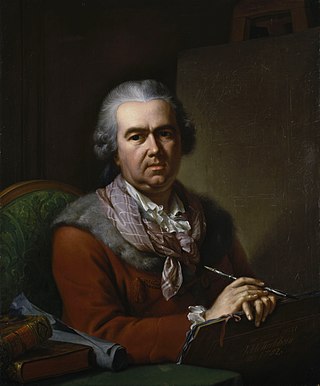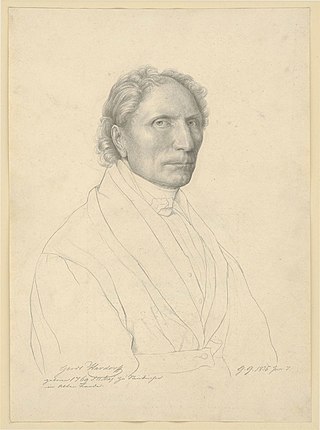
Johann Anton Tischbein (28 August 1720, Haina - 26 July 1784, Hamburg) was a German painter and art teacher from the Tischbein family of artists.

Johann Anton Tischbein (28 August 1720, Haina - 26 July 1784, Hamburg) was a German painter and art teacher from the Tischbein family of artists.
He was the fourth son of the baker, Johann Heinrich Tischbein (1682-1784), five of whose eight children became painters. After a short time at school, he worked as a carpenter in Frankfurt. [1] Later, he went to Paris to learn the art of wallpaper painting, which was very popular among the aristocracy at that time. When his studies were completed, he set up a studio in Frankfurt.
In 1749, he and his brother Johann Heinrich took a study trip to Italy. For many years thereafter, he created oil paintings based on the sketches and watercolors made during that trip.
In 1764, he moved to Hamburg, opened a private art school and was married in 1766. [1] Five years later, he wrote a textbook on painting (Unterricht zu gründlicher Erlernung der Malerey) which, in 1780, earned him a place as an instructor at the Gelehrtenschule des Johanneums. [1] He also painted several murals at Wandsbek Castle, which was demolished in 1861.
A street is named after him in Hamburg's Barmbek-Nord district.

Johann Heinrich Tischbeinthe Elder, known as the Kasseler Tischbein, was one of the most respected European painters in the 18th century and an important member of the Tischbein family of German painters, which spanned three generations.

Johann Heinrich Wilhelm Tischbein, known as the Goethe Tischbein, was a German painter from the Tischbein family of artists.

Haina (Kloster) is a municipality in Waldeck-Frankenberg in northwest Hesse, Germany.

Georg Melchior Kraus was a German painter. He was a co-founder of the Weimar Princely Free Drawing School, together with Friedrich Justin Bertuch, in 1776.

Johann Heinrich Meyer was a Swiss painter, engraver and art critic. He served as the second Director of the Weimar Princely Free Drawing School. A close associate of Johann Wolfgang von Goethe, he was often referred to as "Goethemeyer".

Friedrich Georg Weitsch was a German painter and etcher.

Pascha Johann Friedrich Weitsch was a German landscape painter and illustrator. His unusual first name was not a nickname derived from the Turkish word "Pasha", as is often stated. It came from his godfather, Pasche Wipperling, and was an abbreviation of "Paschalis".

Friedrich Carl Gröger was a north-German portrait painter and lithographer. One of the most respected portraitists of his time in northern Germany, his works are to be found in several museums, including the Hamburger Kunsthalle, as well as in north German, Holstein and Danish private collections.

Johann Friedrich August Tischbein, known as the Leipziger Tischbein was a German portrait painter from the Tischbein family of artists.
The Tischbein family was a German family of artists, originating in Hesse and spanning three generations. The family patriarch, Johann Heinrich Tischbein (1682–1764), was a master baker at the State Hospital in Haina. The Tischbeins also produced a number of master carpenters..

Johann Valentin Tischbein was a German painter from the Tischbein family of artists.

The Casa di Goethe is a museum in Rome, in Via del Corso 18, dedicated to Johann Wolfgang von Goethe, his Italian Journey and his life at Rome in the years from 1786 through 1788. During his journey Goethe wrote a journal and also many letters which would be published in 1816-17 as the Italian Journey.

Carl Peter Burnitz was a German landscape painter who began as a lawyer.

Goethe in the Roman Campagna is a painting by Johann Heinrich Wilhelm Tischbein, a German Neoclassical painter, depicting Johann Wolfgang von Goethe when the writer was travelling in Italy. Goethe's book on his travels to Italy from 1786 to 1788, called Italian Journey, was published in 1816–17; the book is based on his diaries. Since 1887, the painting has been in the possession of the Städel Museum in Goethe's hometown Frankfurt.

August Albrecht Christian Tischbein was a German painter and lithographer from the Tischbein family of artists.

Johann Heinrich Tischbein, known as The Younger was a German painter and engraver from the Tischbein family of artists.

Johann Heinrich Lips was a Swiss copper engraver; mostly of portraits.
Gotthelf Leberecht Glaeser was a German painter of the Biedermeier movement.

Gerdt Hardorff was a German painter, art collector and drawing teacher. He is sometimes referred to as The Elder to distinguish him from his son, Gerdt, who also became a painter.
Friedrich Ludwig Heinrich Waagen also Christian Friedrich Ludwig Heinrich Waagen, Wagen or Wage) was a German portrait, history and landscape painter born in the Holy Roman Empire. Hardly anything is known about his works. However, he had acquired extensive knowledge of art, amassed a collection of paintings in Hamburg and was known to friends with or in-laws of many important personalities of his time. Gustav Friedrich Waagen (1794-1868) and Carl Waagen (1800-1873) are his sons.